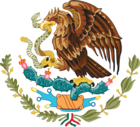Coat of Arms of Mexico
From Wikipedia, the free encyclopedia.
| This article is the current Mexico Collaboration! | |
| Please help to improve it to match the quality of an ideal Wikipedia Mexico related article. |


The Coat of Arms of Mexico was inspired in the Aztec tradition of the founding of Tenochtitlan. According to popular legend, the Aztec people, then a nomadic tribe, were wandering in Mexico in search of a sign that their god Huitzilopochtli had commanded them to find an eagle perched atop a cactus, devouring a snake. After two hundred years of wandering, they found the promised sign on a small island in the swampy Lake Texcoco. Here they founded their new capital, Tenochtitlan.
But a closer look at the original Aztec sources, codex, paintings and postcortesian codex, show there is no snake in the original legend. In some Aztec illustrations, like the Mendoza codex, there is only an eagle, while in some the eagle is devouring a bird, and others show the eagle has the symbol of Atl-Tlachinolli or burning water - the symbol of war - and which to the untrained eye may look like a snake.
The eagle is the symbol of the sun, and the snake is the symbol of Quetzalcoatl. The story of the snake was a mistranslation of the Mexicayotl chronicle by Alvaro Tezozomoc, and adopted because it conformed with European heraldic tradition. It would represent the struggle between good and evil, which is not from prehispanic traditions, but is an element that could be used by the first missionaries for evangelization.
The original meaning of the symbols, the eagle as a representation of the sun god, Huitzilopochtli, since the Aztec referred themselves as the People of the Sun; the cactus, full of its fruits "tenochtli" in a small island represents the name of Tenochtitlan.
This version would be used for the first time in 1581 by Diego Durán and adopted by others, but it would not be until the war of independence, that it would be used as a coat of arms.
The coat of arms of Independent Mexico which was adopted in 1821, depicts a golden eagle, called in Spanish águila real, eating a snake that it is holding in its claw and an imperial crown.
In 1823, the crown would be removed, and new elements from European tradition would be introduced to celebrated the victory of the republic. During the 19th century, the position of the eagle changed several times, and the imperial crown returned for a time under the Second Mexican Empire.
In 1887 President Porfirio Diaz would make change to represent the eagle following the french style.
In 1916, Venustiano Carranza reverted the changes by Diaz, and restored some of the original Aztec symbols.
In 1968, President Gustavo Diaz Ordaz ordered a small change, so the eagle would look more aggresive, and this design, by painter Francisco Eppens Helguera, is used today.
The design also forms the center of the Mexican flag.
See also
The Tale of the Eagle: a legend from Albania explaining the origin of their indigenous name, which also features an eagle with a snake.



